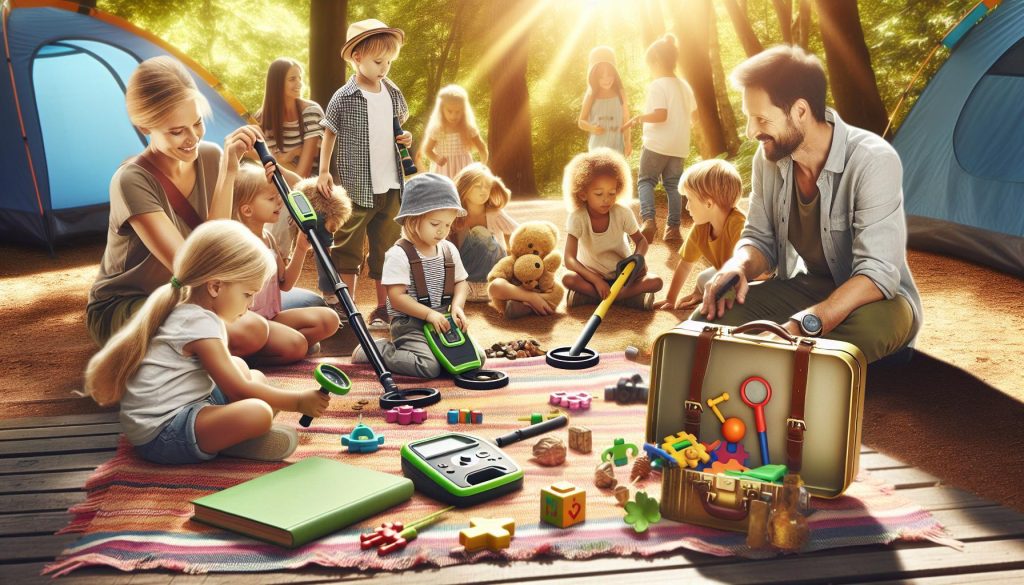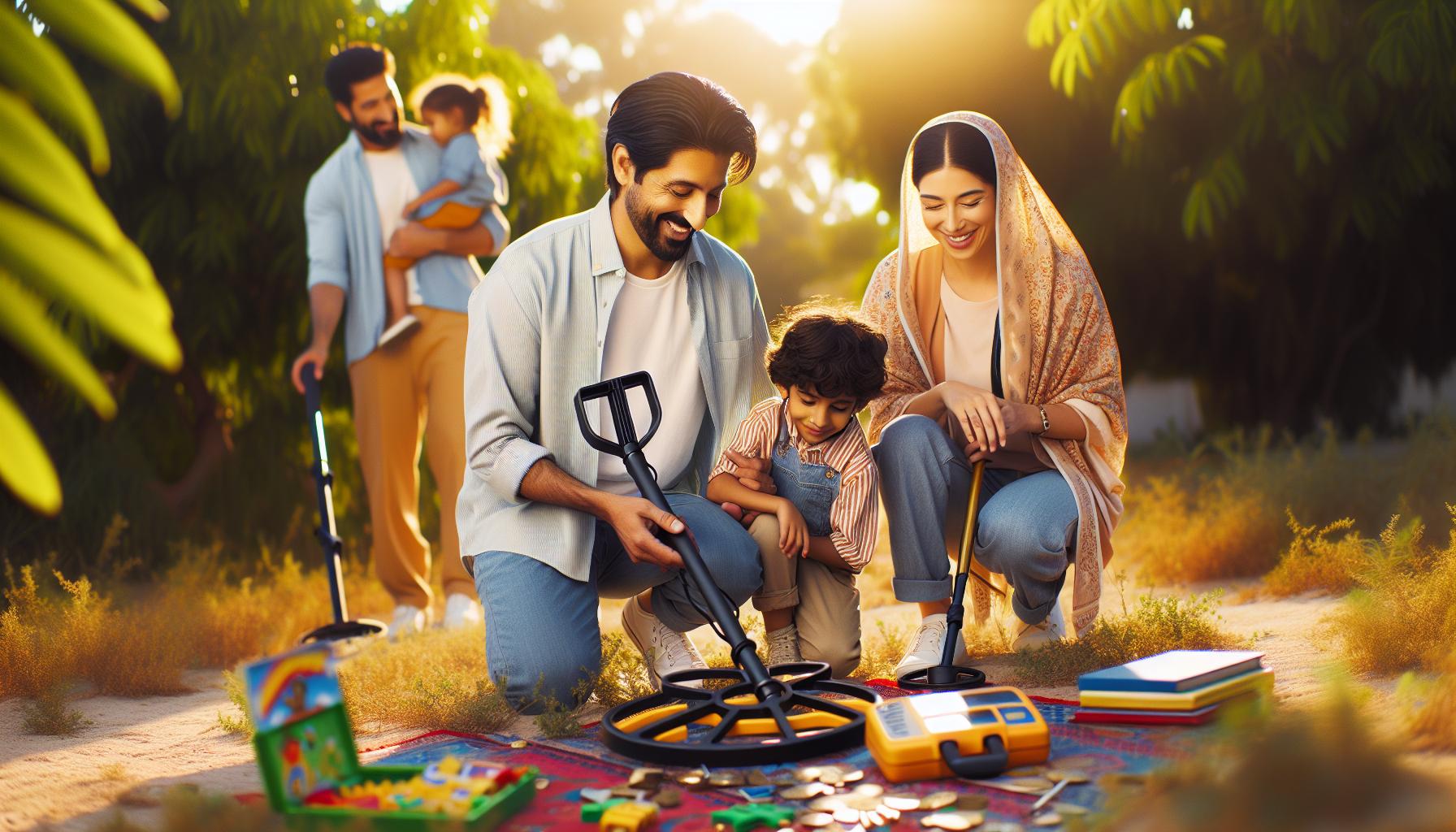Best Metal Detectors for Kids: Turn Treasure Hunts Into Adventures
Are your little ones dreaming of becoming the next great treasure hunter, just like Indiana jones or Captain Jack Sparrow? well, grab your shovels and dust off those pirate hats, as we’ve got the ultimate guide too transforming backyards into treasure-laden adventures! In our article, “Best Metal Detectors for Kids: Turn Treasure Hunts Into Adventures,” we’ll equip you with the insider scoop on the top metal detectors that are perfect for tiny treasure seekers.Imagine the joy on their faces as they unearth hidden treasures—and maybe even a few old cans—while you sit back with a refreshing drink (or a slightly jealous frown). With options that are lightweight, easy to use, and come with features designed just for kids, watch as they embark on epic quests without a single map or compass. So, let’s dig into the best metal detectors that will turn every outing into a memorable adventure!
Understanding the Importance of metal Detecting for Children
Engaging in metal detecting offers children a unique blend of education, physical activity, and adventure. This activity not only sparks curiosity in young explorers but also instills essential life skills that will benefit them throughout their lives. Here’s why it’s pivotal for kids:
- Promotes Critical Thinking: As kids search for buried treasures, they learn to analyze different environments, evaluating where treasures might be hidden. This critical thinking fosters problem-solving skills as they assess the data collected by their metal detectors.
- Encourages Outdoor Activity: In an age dominated by screens,metal detecting provides a compelling reason for children to step outside. it invites them to explore local parks, beaches, and historical sites, encouraging physical activity and promoting a healthy lifestyle.
- Boosts Patience and Persistence: Treasure hunting often requires time and patience. Kids learn that not every dig yields results, helping them develop perseverance and resilience as they refine their techniques.
- Enhances Social Skills: Whether hunting alone or in groups,metal detecting can cultivate teamwork and communication. Children frequently enough discuss their finds, share tips, and collaborate on treasure hunts, fostering friendships and social connections.
Additionally, metal detecting offers a bridge to history, making it an educational tool for young learners. Each finding tells a story,whether it’s an old coin,a piece of jewelry,or a relic from a past era. This aspect ignites children’s imaginations and can inspire a lifelong passion for history and archaeology. Engaging with the past through tangible artifacts nurtures a deeper understanding of history and its importance.
Incorporating metal detecting into children’s activities translates learning into hands-on experiences. As they search for hidden treasures, they gain knowledge about the surroundings, geology, and even local history. With a growing interest in science, math, and technology, kids develop a multifaceted skill set that aligns with educational standards while enjoying the thrill of discovery.
Key Features to Look for in a Children’s Metal Detector
When selecting a metal detector for children, there are several essential features that can enhance their treasure-hunting experience. Here are some factors to consider:
- Weight and Ergonomics: A lightweight design is crucial for kids, as it allows them to easily maneuver the detector over longer periods without feeling fatigued. Look for models with adjustable shafts to accommodate growing children.
- Sensitivity and depth Detection: Even though kids are often on the lookout for surface treasures, a detector with adjustable sensitivity will help them discover buried coins and relics. Beginners should ideally start with a device that provides depth indication for an added layer of engagement.
- Durability and Weather Resistance: Kids can be rough on their gear, so a sturdy build is essential.Seek out metal detectors that offer some level of water resistance and can withstand outdoor conditions—from sandy beaches to muddy parks.
- User-Friendly Interface: Simplicity can make all the difference. Look for detectors featuring intuitive controls, with clear signals or lights to indicate findings, ensuring even the youngest users can operate them with ease.
Also consider the following features when making your choice:
| Feature | Importance |
|---|---|
| Visual Display | Helps kids understand which metals are detected. |
| Sound Alerts | Provides immediate feedback; different tones for different metals can be exciting! |
| Adjustable Settings | Allows beginners to learn at their own pace and grow into more advanced features. |
| Warranty and Support | Assures parents of a quality product and support if issues arise. |
Choosing the right features can considerably enhance the experience for young treasure hunters, fostering a love for adventure and exploration that lasts a lifetime. Equip them with the right metal detector, and watch their imaginations soar as they venture into the great outdoors, ready to uncover hidden treasures!
Top Metal Detectors for Kids: Performance and User Reviews
When it comes to choosing the right metal detector for kids, performance and user reviews play a crucial role in ensuring a rewarding experience. We have gathered insights on some of the most popular models that cater specifically to young treasure hunters, focusing on their features, ease of use, and overall satisfaction among users.
- Kiddey Metal Detector: this model is known for its lightweight design, making it perfect for kids. With a detecting depth of up to 6 inches, it features simple controls that help children easily learn the basics of treasure hunting. User reviews frequently enough highlight its durability and effectiveness, especially in parks and sandy areas.
- Bounty Hunter Junior: Renowned for its user-friendly interface, the Bounty Hunter Junior is a favourite among parents.It provides an adjustable sensitivity feature that allows kids to find coins and relics within a modest depth range. Feedback often praises its robust construction and the excitement it brings to outdoor adventures.
- National Geographic Kids metal Detector: This model stands out for its educational components. it’s designed to be intuitive, with a feature that provides auditory signals when metal is detected.Parents appreciate the included guidebook that teaches kids about different types of metals, fostering learning alongside exploration.
- Treasure Cove Metal Detector: Tailored for children, this detector has a stylish design and fun colors. Users report that its lightweight construction allows for extended use without fatigue. It boasts a detecting depth of up to 5 inches and is waterproof, making it suitable for beach trips or rainy day adventures.
| Model | Depth Detection | Weight | Rating |
|---|---|---|---|
| Kiddey Metal Detector | 6 inches | 2.5 lbs | 4.5/5 |
| Bounty Hunter Junior | 5 inches | 2.0 lbs | 4.7/5 |
| National Geographic Kids | 4 inches | 2.7 lbs | 4.6/5 |
| Treasure Cove | 5 inches | 3.0 lbs | 4.3/5 |
Choosing a metal detector that combines performance with positive user feedback can significantly enhance a child’s treasure hunting experience. Each of these models has been tried and tested, proving that with the right tools, adventures await right outside your door.
Safety Considerations When Metal Detecting with Kids
Engaging in metal detecting activities with kids can be an exhilarating experience, but safety should always be at the forefront. Being well-prepared helps ensure fun and excitement without incidents.Here are some essential safety considerations to keep in mind:
- Supervision: Always supervise young children while using metal detectors. Even if they are skilled with the equipment, keep a close eye on their movements, especially in unfamiliar terrain.
- Protective Gear: Equip children with proper gear, including gloves to protect their hands from sharp objects and sturdy shoes to shield their feet.
- Check the Environment: Before heading out, ensure that the search area is safe. Avoid locations near busy roads or hazardous environments like construction sites.
- Sun and Weather Protection: Dress kids appropriately for the weather.Use sunscreen, hats, and hydration packs to prevent sunburn or dehydration during long outings.
Additionally, educating kids about the surrounding environment is crucial.Teach them to avoid areas that may contain perilous debris, and explain how to recognize potentially hazardous situations such as:
| Hazard | Description |
|---|---|
| Sharp Objects | Stay clear of broken glass, rusty metal, and other sharp debris. |
| Wildlife Encounters | Beware of snakes or insects that could pose a bite risk. |
| Unstable Ground | Avoid areas with potential sinkholes or unstable cliffs. |
instilling the importance of environmental stewardship is essential. Teach children to respect the areas they explore by practicing “Leave No Trace” principles, which include:
- Filling in holes: Always cover up any holes or disturbances made while detecting.
- Taking trash: Encourage kids to pick up litter they find to leave the area cleaner.
- Respecting Property: Always seek permission when detecting on private lands and adhere to local regulations.
By integrating these safety measures into your treasure hunting adventures, you can foster a positive and secure experience for the entire family.
Tips for a Successful Treasure Hunting Experience
Embarking on a treasure hunt can be exhilarating, but ensuring a successful adventure requires some preparation. First and foremost, familiarize yourself with the metal detector’s features. Knowing how to adjust sensitivity settings, discrimination modes, and volume control will maximize your chances of finding hidden treasures. Spend some time practicing in your backyard to build confidence and skill before heading out to more challenging locations.
Choosing the right location is crucial for an enjoyable treasure hunting experience. Consider these factors for an optimal site:
- Popular Parks: Look for crowded parks where visitors may have lost items over time.
- Beaches: These areas tend to have many lost treasures, especially during peak season.
- historical Landmarks: Research local history to identify spots where people historically gathered.
- Private Properties: With permission, private lands can yield unique finds.
before setting out, equip yourself with the right gear to enhance your treasure hunting experience:
- Headphones: Using headphones helps you focus on the faint sounds of signals.
- Shovel or Digging Tools: Make sure to carry lightweight tools for easy digging.
- Trash Bag: Always clean up after yourself by collecting any litter you may find during your search.
Document your finds for a more rewarding experience.Consider keeping a treasure hunting journal where you note:
| Date | Location | Item Found | Approx. Value |
|---|---|---|---|
| June 10, 2023 | Sunny Beach | Silver Ring | $45 |
| June 15, 2023 | Maple Park | Old Coin | $15 |
| June 20, 2023 | Old Mill Site | Vintage Button | $5 |
This not only enhances your treasure hunting experience but also creates fantastic memories to share with family and friends. Happy hunting!
Engaging Activities to Enhance the Adventure of Metal Detecting
Transforming a simple treasure hunt into a grand adventure can be both engaging and educational for kids. Here are some captivating activities that add excitement to metal detecting outings:
- Theme Days: Choose a specific theme for your treasure hunt, such as pirates or ancient civilizations. Dress the kids in appropriate costumes and tailor the detecting experience around the chosen theme. This can spark their imagination and enhance the enjoyment of finding “lost treasures.”
- Scavenger Hunts: Create a list of items to find, including specific types of coins, jewelry, or unique objects. This adds a competitive element and encourages kids to explore different areas, honing their detecting skills while making the adventure more thrilling.
- History Integration: Incorporate local history by researching the area where you’re detecting. Kids can learn about the significance of different historical items and how they relate to the treasures they may unearth.Bringing history to life in this way fosters deeper interest and learning.
- Buddy System: Pair the kids up for the hunt. This encourages teamwork, communication, and collaboration as they share tips and discoveries. It also enhances the social aspect of metal detecting, making it a fun group activity.
To keep track of their findings and learning during the adventures,consider using a simple tracking chart:
| Item Found | Location | Date | Notes |
|---|---|---|---|
| Old Coin | Park | 2023-10-15 | Possible 1945 dime. |
| Ring | Beach | 2023-10-20 | Looks like gold! |
| Button | Schoolyard | 2023-10-22 | Antique style. |
This not only tracks their achievements but also encourages documentation skills, allowing kids to share their findings and stories with others. By incorporating various engaging activities, you can foster a deeper love for metal detecting and create unforgettable adventures for young treasure hunters.
Maintaining and Caring for Your Child’s Metal Detector
Taking care of your child’s metal detector not only extends its lifespan but also enhances their treasure hunting experience. By implementing a few simple maintenance practices,you can ensure that the device remains in excellent working condition and continues to uncover hidden treasures.
- Regular Cleaning: After each use,clean the metal detector to remove dirt and debris. Use a soft cloth for the exterior and a brush for the coil. Avoid using harsh chemicals which could damage the components.
- Battery Care: make it a habit to check the batteries before each outing. If the detector uses rechargeable batteries, ensure they are fully charged. For non-rechargeable batteries, replace them promptly when they start to show signs of weakness.
- Storage Tips: Store the metal detector in a cool, dry place away from direct sunlight. Consider using a protective case to shield it from dust and accidental impacts.
- Regular Inspections: Periodically inspect the detector for any signs of wear and tear. This includes checking the coil and any wires for fraying or damage. Addressing these issues early can prevent more notable problems down the line.
Additionally, fostering a sense of obligation in your child about caring for their equipment can enhance their thankfulness for the hobby. Teach them the importance of handling the detector gently and looking after their tools. This not only instills good habits but also enriches their overall treasure hunting experience, making it more enjoyable and rewarding.
| Maintenance Task | Frequency |
|---|---|
| Clean the Detector | after Each Use |
| Check Batteries | Before Every Use |
| Inspect for Damage | Monthly |
| Store Securely | After Each Use |
Frequently asked questions
What are the key features to consider when choosing a metal detector for kids?
When selecting a metal detector for children, several key features are essential to ensure a positive and safe treasure-hunting experience. Weight and Size are critical; you want a detector that is lightweight and ergonomically designed. Most models suitable for kids weigh between 2 and 3 pounds, making them easy for small hands to handle. Look for detectors with adjustable shafts that can grow with your child, ensuring extended usability.Sensitivity and Depth range are also important aspects. A beginner-friendly detector should be sensitive enough to detect coins or small treasures buried just a few inches deep, typically around 6-8 inches. Models like the Bounty Hunter Junior are known for their effective detection capabilities, allowing kids to explore various terrains without frustration. Additionally, features like visual displays, volume control, and adjustable sensitivity settings help tailor the experience to a child’s needs.
consider the durability and ease of use. Kids can be tough on equipment, so choose a model made with sturdy materials that can withstand drops and rough handling. User-friendly interfaces with simple controls will make it easier for kids to learn and enjoy the hobby without overwhelming them. A good example is the National Geographic Junior Metal Detector, which is specifically designed for younger users, combining durability with straightforward functionality.
are there specific age recommendations for different metal detector models?
Yes, age appropriateness is a significant factor when selecting a metal detector for kids. Many manufacturers provide age guidelines for their products, helping parents choose the right model. Generally, detectors aimed at younger children, typically aged 5-8, are simpler, lightweight, and frequently enough come in fun colors and designs. These detectors usually have basic features, making them easy for kids to operate without getting confused. A prime example is the Bounty Hunter Junior, which is an excellent starter model for this age group.
For children aged 9 and older, you can look into more advanced detectors that offer additional features such as discrimination modes (which help filter out unwanted metals) and better depth detection.Detectors like the Fisher F22 or the Minelab Go-Find 44 are excellent choices as they are user-friendly yet still provide a variety of settings to enhance the treasure-hunting experience. These models are lightweight and designed with ergonomic features to cater to slightly older children, accommodating their growing physical abilities.
It’s worth noting that interest in treasure hunting can vary widely, and while age recommendations are helpful, personal interest plays a huge role in engagement. Thus, consider your child’s enthusiasm for adventure and exploration alongside the age guidelines when making a purchase.
How much should I expect to spend on a quality metal detector for my child?
The cost of metal detectors can vary widely based on features, brand, and intended use. For children’s models,you can find a variety of options ranging from $40 to $150. Budget-friendly detectors, like the Bounty Hunter Junior, often fall in the lower range and provide great functionality without breaking the bank. These models can effectively detect coins and small items, making them suitable for casual treasure hunters.
If you’re looking for more advanced features—such as better depth detection, discrimination, or increased sensitivity—you might consider investing between $150 to $300.Models such as the Minelab Go-Find 44 or the Fisher F22 can be found within this range and provide additional capabilities that will enhance the treasure-hunting experience. While pricier, these models often come with features that make the hobby more engaging and successful for older or more serious young treasure hunters.
It’s important to remember, though, that you don’t always need to invest a lot of money upfront. Start with a budget-friendly option to see if your child enjoys the hobby before moving on to higher-end models. Many families find that kids can become quite passionate about treasure hunting, making the investment worth it in the long run.
What safety precautions should be taken while using metal detectors?
When engaging in treasure hunts with kids using metal detectors,safety should always be a priority. First and foremost, it’s crucial to supervise children during the activities. Kids should be instructed on how to operate the detector properly and safely handle the equipment, especially when digging. Ensure they understand the importance of keeping the detector away from their face and eyes while in use.
Another important consideration is the environment in which the treasure hunt takes place. Before heading out,parents should inspect the area to ensure it is safe for children to dig. This includes avoiding locations with heavy foot traffic, sharp objects, or potentially hazardous materials. Teaching kids to scan the ground for potential dangers before they start digging can also prevent injuries.
Additionally, it’s wise to educate children about the local laws and regulations regarding metal detecting. Some areas may have restrictions on digging or may require permits, especially in public parks or historical sites. Instilling a sense of responsibility about respecting these regulations ensures not only a safer experience but also promotes good citizenship and respect for shared public spaces.
What type of batteries do kids’ metal detectors use, and how long do they last?
Most metal detectors designed for kids typically utilize either AA or 9V batteries, with AA batteries being the more common choice due to their availability and ease of replacement. Models like the Bounty Hunter Junior, as an example, use 2-3 AA batteries, making it easy for parents to find replacements. The battery life can vary significantly depending on usage, but many detectors boast an operational time of around 20-30 hours per set of batteries, which is often enough for multiple treasure-hunting excursions.
To maximize battery life, it is indeed advisable for parents to encourage kids to turn off their detectors when not in use. Some models even include features like automatic shut-off to help conserve power, which can be helpful during long treasure hunts. additionally, rechargeable batteries can be a savvy investment, allowing families to save money and reduce waste in the long run.
It’s also worth considering that as technology advances, some metal detectors now come equipped with built-in rechargeable lithium-ion batteries. These can provide longer and more consistent usage without the need for constant battery replacements.For example, the Minelab Go-Find 44 model features a built-in rechargeable option, allowing for a more eco-friendly and cost-effective approach to powering the device.
How can metal detecting enhance children’s learning experiences?
Metal detecting is more than a fun outdoor activity; it can significantly enrich a child’s learning experience across various educational aspects.History and Archaeology become engaging subjects when kids are actively involved in seeking artifacts or old coins.Finding a historic item can spark curiosity and foster discussions about the past, teaching children about local history, cultures, and the significance of artifacts in understanding societal development.
Another dimension is Science. exploring concepts of magnetic fields, metal conductivity, and the physical properties of different metals can be incredibly engaging for young learners. As children dig up their finds, they can learn about soil layers, geology, and the environmental factors that contribute to the preservation of objects over time. Through this hands-on approach, they can grasp scientific concepts in a tangible way.
moreover, metal detecting promotes problem-solving skills and enhances patience and perseverance. As kids learn to interpret the signals from their detectors and decide where to dig, they develop critical thinking and decision-making abilities. The thrill of finding something unique can boost confidence and encourage a sense of achievement. Together, these aspects make metal detecting a multifaceted educational tool that enriches childhood learning experiences beyond the typical classroom environment.
Wrapping Up
As we’ve explored, metal detecting for kids is not just a thrilling pastime, but a fantastic way to blend education with adventure. The right metal detector can ignite curiosity, encourage outdoor exploration, and even teach valuable skills such as patience, problem-solving, and an appreciation for history as they uncover hidden treasures. From lightweight options designed for younger treasure hunters to more advanced models that won’t outgrow their interest, the choices are vast and varied.
investing in a quality metal detector that aligns with your child’s age, interests, and experience level ensures a rewarding experience. Remember to consider factors like ease of use, durability, and the detector’s depth capabilities, as these can significantly enhance their treasure hunting experience. Encouraging children to embark on these adventures not only fosters a sense of excitement but also strengthens their connection to the world around them.
So gear up, head outdoors, and let the adventure begin! With the right equipment in hand, your children won’t just search for treasures buried in the ground; they’ll uncover a world of learning, imagination, and discovery. Happy hunting!





